Quick Reference
c. 1930
West Hawley, MA
Oil on Canvas
Landscape
Apples, Houses, People,
Even in November, Rock walls
25" x 30"
Grand Central Galleries (NY),'31,'32
Mt. Holyoke Coll. Dwight Hall, 1931
Springfield Museum of Fine Art, '31
Amherst Coll. Jones Library, 1932
Valleyhead Sanitarium, 1932
Deerfield Academy, 1935
Southern Vermont AA, 1935
St. Paul's School, Concord, NH, '35
Winchester AL, 1937
Vose Galleries (Boston), 1941, '42
Westfield Athenaeum, 1941
1st Nat. Bank of Greenfield (MA), '42
Home of Mr. & Mrs. Roger Smith, '44
Miss Esther Garbose
N/A
Woodward did not start to assemble his painting diary until the 1940s and so his remarks about how he felt with regard to this painting carries greater weight than if he had written it in 1930 before he made hundreds of more canvases.
Related Links
- See also the...
734.png) "Even in November" gallery to view related work.
"Even in November" gallery to view related work.
- See also The Little Farmhouse for a related piece of work.
- See also the...
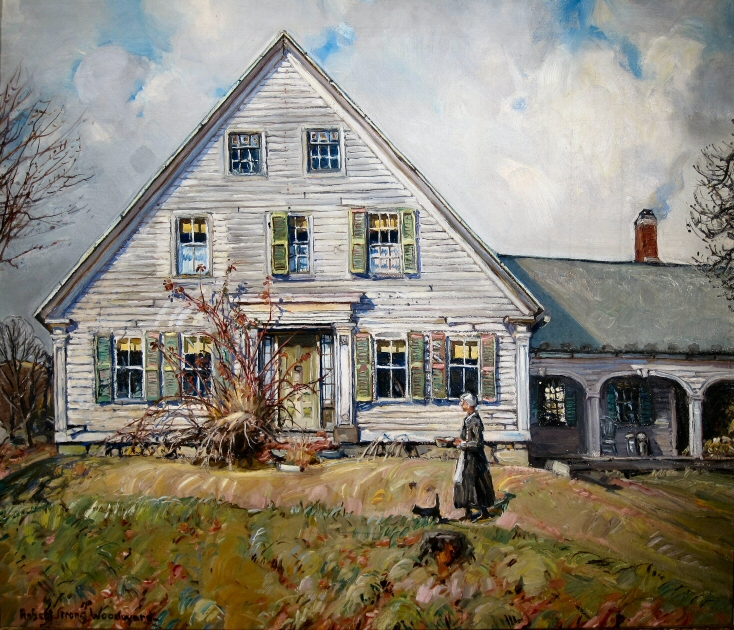 Houses Gallery to view related pieces.
Houses Gallery to view related pieces.
- See also the...
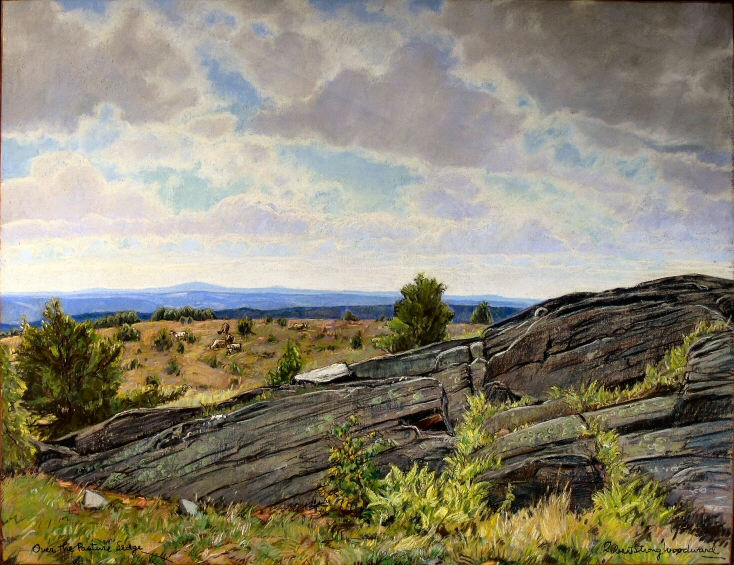 Rocks & Stone Walls Gallery to view related pieces.
Rocks & Stone Walls Gallery to view related pieces.
- See also the...
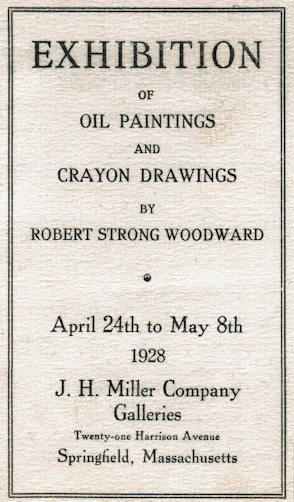 Exhibition List for a complete list of events
Exhibition List for a complete list of events
- See also the...
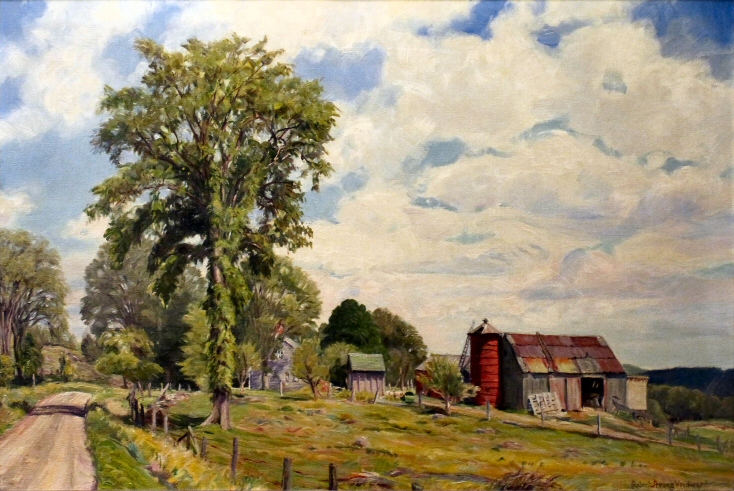 Farms Gallery to view related pieces.
Farms Gallery to view related pieces.
- See our page devoted to ...
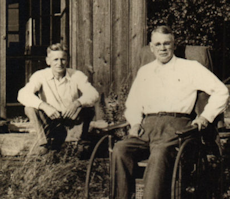 RSW friend and Hollywood Interior Designer F. Earl Williams
RSW friend and Hollywood Interior Designer F. Earl Williams
- See also the Scrapbook page of photos taken by Mr. F. Earl Williams
- See also the...
 Apples Gallery to view related pieces.
Apples Gallery to view related pieces.
- See also the...
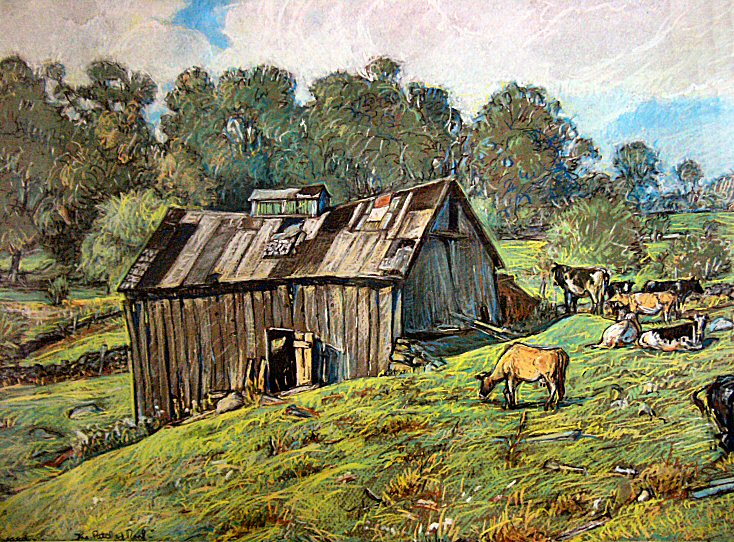 People & Livestock Gallery for related pieces.
People & Livestock Gallery for related pieces.
- Read Our Essay on ...
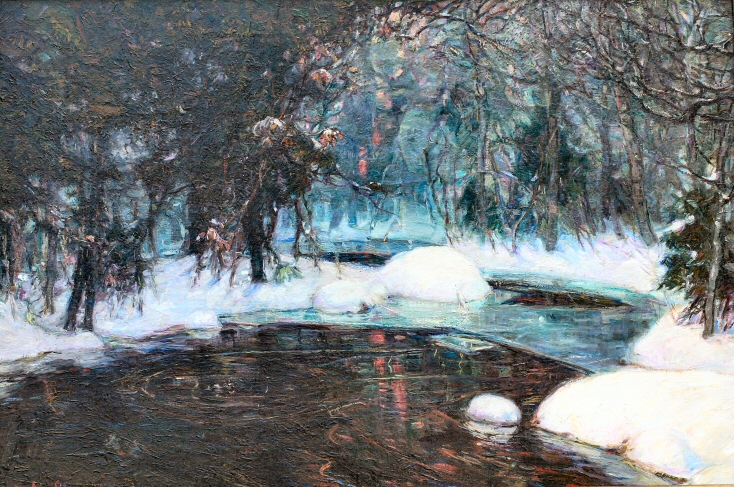 The Winter Evening Stream Paintings
The Winter Evening Stream Paintings
- See also the...
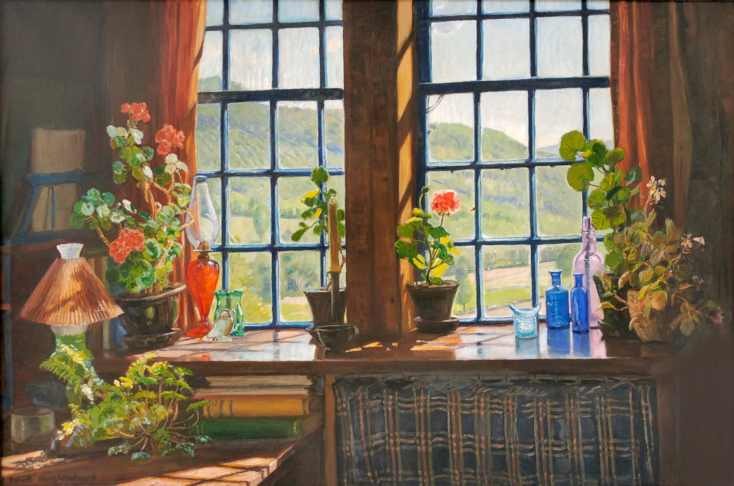 Window Picture Gallery to view related pieces.
Window Picture Gallery to view related pieces.
Featured Artwork: Portrait of a Shadow
RSW's Diary Comments
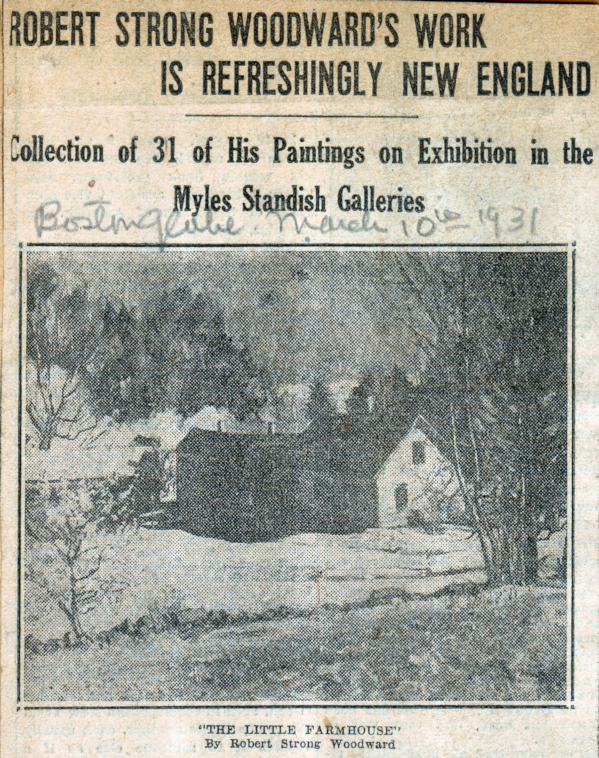
 Boston Globe, March 10, 1931, by A.J. Philpott
Boston Globe, March 10, 1931, by A.J. Philpott
The caption of the above article is incorrect. The pic-
ture in the painting is Portrait of a Shadow which
also exhibited at the 1931 Myles Standish Gallery.
Woodward created this confusion with a story how
he ALMOST named this painting the named caption.
"Painted 1931 or '32. A canvas I have loved myself and admired more than any other I ever made. Very much exhibited and praised canvas but for some strange reason one that has never sold up to this writing (1942). Painted from the lower field of the Stetson farm in West Hawley, of the back of the little farm house just below the Stetson place. Sold Nov. 1943, to Miss Esther Garbose of Gardner, Mass."
Editor's Note:
For years this painting was believed to be initially named, The Little Farmhouse, however, it has since been proven to be a mistake. For the whole story see, The Little Farmhouse. To summarize here, Woodward told the story to two art critics about how he "almost" named this painting The Little Farmhouse. The story confused the critics because the artist DID name a painting by that name, and it has been proven to be a wintery scene. Besides, Portrait of a Shadow hung two months prior in New York City at the Grand Central Art Galleries, months before The Little Farmhouse hung at the Myles Standish Gallery in Boston. Confusing matters even more Portrait of a Shadow ALSO hung at Myles the same month but was not on the exhibition list most likely because it was again confused with The Little Farmhouse, so much so that it was mistakenly captioned by the newspaper as The Little Farmhouse.
-sigLG.png?url=photos/portrait_of_a_shadow(25)-sigLG.png)
 RSW's signature from the lower right of the
RSW's signature from the lower right of the
painting. To the right, its stretcher with name... ⮞
-stretcherLG.png?url=photos/portrait_of_a_shadow(25)-stretcherLG.png)
Additional Notes

 The picture above is of the March 1931 Myles Standish Gallery Exhibition. We know this because (1)
we have other pictures of the gallery that are labeled "Myles Standish." But also (2) we know it
is March and not February's show because of the combination of paintings. For instance, When
Sap Runs only hung with Keach's Stove in March. From there we check off the other
recognizable paintings for matches which we did not do too well. The problem is the bright light
coming in from the windows of the gallery are blowing out some of the canvases. The one we think
might be Portrait of a Shadow was determined by the the contrasting positions of the light
and dark objects. You can see how bright the light is on the painting by looking below the frame.
That is as "hot" as need be to neutralize most of the elements except the darkest of darks. Still,
there is dark where you expect to see dark especially the shadow near the middle. We had the same
problem with White Clouds and used the same techniques.
The picture above is of the March 1931 Myles Standish Gallery Exhibition. We know this because (1)
we have other pictures of the gallery that are labeled "Myles Standish." But also (2) we know it
is March and not February's show because of the combination of paintings. For instance, When
Sap Runs only hung with Keach's Stove in March. From there we check off the other
recognizable paintings for matches which we did not do too well. The problem is the bright light
coming in from the windows of the gallery are blowing out some of the canvases. The one we think
might be Portrait of a Shadow was determined by the the contrasting positions of the light
and dark objects. You can see how bright the light is on the painting by looking below the frame.
That is as "hot" as need be to neutralize most of the elements except the darkest of darks. Still,
there is dark where you expect to see dark especially the shadow near the middle. We had the same
problem with White Clouds and used the same techniques.
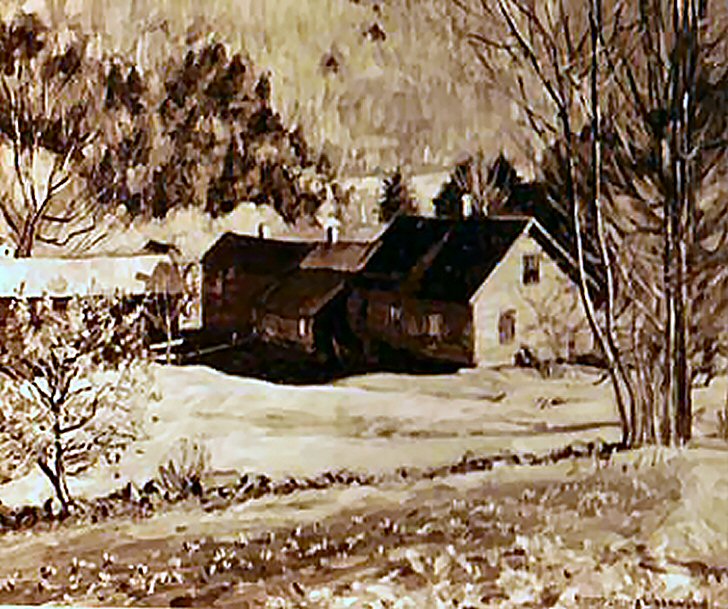
 Portrait of a Shadow Sepia Print
Portrait of a Shadow Sepia Print
This is one of Woodward's most loved paintings. He says as much, but like his perhaps second favorite canvas, Mrs. Keach's Front Porch or third The Old House and The Young Tree the critics did not swoon over it as much as they did, The Little Farmhouse which was mention in a few columns at shows it appeared. It never got the praise The Old House and The Young Tree did when it hung at Boston's Society of Contemporary Artists inaugural show in January of 1930, or holds nearly the charm of Mrs. Keach's Front Porch. In fact, Portrait of a Shadow is not singled out once on its own. It is only mentioned with other paintings and not just once but three times. There is something else to it we are not seeing and Woodward is not telling. He'd prefer we discover it on our own anyway.
-the_manSM.png?url=photos/portrait_of_a_shadow(25)-the_manLG.png)
 A close up of man and his shadow. A critic once
A close up of man and his shadow. A critic once
suggested that some of RSW's work was prosaic, lack
-ing poetic beauty... and yet he makes it charming. This
scene fits that description best. We call it wabi-sabi,
the Japanese aesthetic of finding beauty and grace in
wretched and ugly circumstances. RSW admired
Japanese art and culture and studied its philosophies.
Do not get us wrong. We love the painting. First, it is an intimate portrait of a New England homestead, weathered by time and the elements common in Woodward's work. There is also a person in the painting on the side of the house by the window. He is casting a shadow much like the home itself suggesting a mirrored reflection of home and owner. It is perhaps this that makes it special to the artist as home is often the personification of the individual living in it. We have trees and stonewalls with an imposing hill but what makes the scene is (1) the time of day. It is later in the day than the norm for Woodward but also (2) it is a November subject. A setting sun in the west casting its shadow over man and home - in November. This is one of the artist most poetic paintings in name and subject.

 A man kicked-back sitting on a chair from with a
A man kicked-back sitting on a chair from with a
chicken and his dog from Passing New England (1933)
The title, Portrait of a Shadow, could be the title of a book by, Hawthorne, Yeats, or Wilde. It is wonderful allegory suggesting that the homestead, its owner, month, and time of day are all aligned in the same phase of age. Yet it is bright and almost cheerful in its presentation. November is the month of retirement, of respite from an impending end. Late afternoon, is a time of little things to wrap up your day. The hard work has already been done. Preparation for tomorrow might be done at this time and in November this could be as late as 4:00 pm, with evening coming soon.This is all imagery of what Woodward often celebrated. The question is why? We believe that in a number of ways, Woodward felt "retired" from the life he had envisioned, and his painting career, the only thing left to him at a point, is what he did with his figurative retirement from his commercial career.
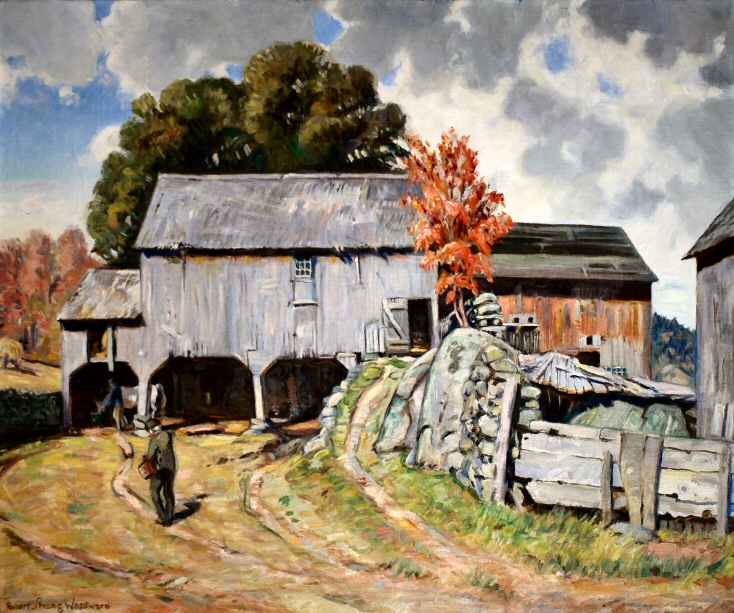
 Silver Barn, 1945 The Stetson Farm barn in
Silver Barn, 1945 The Stetson Farm barn in
West Hawley neighboring the homestead seen in the
painting, Portrait of a Shadow See Below ⮟
This imagery shows itself
over and over again in so many of his paintings. His Winter Evening Stream paintings and his early wooded
interiors where often made at dusk as the sun sets and moon rises. His homes where people are visible. Most
of them are resting or doing something mundane like bringing milk to a cat. In
Passing New England there is literally a man on a chair kicked back leaning against a wall just
inside his garage. He looks like he made be whittling something.
There are still two more sections
below. We have a letter Woodward wrote to Vera Stetson a neighbor of the subject of the painting with the
hope she show her neighbor the clipping he added in the letter with the neighbor. That is followed by the
story of the 1943, Smith Home exhibit in Gardner, MA, featuring a number of the artist's most admired
canvases, including Portrait of a Shadow.
---------------------------------------------------------------------------------------------------------------------------------
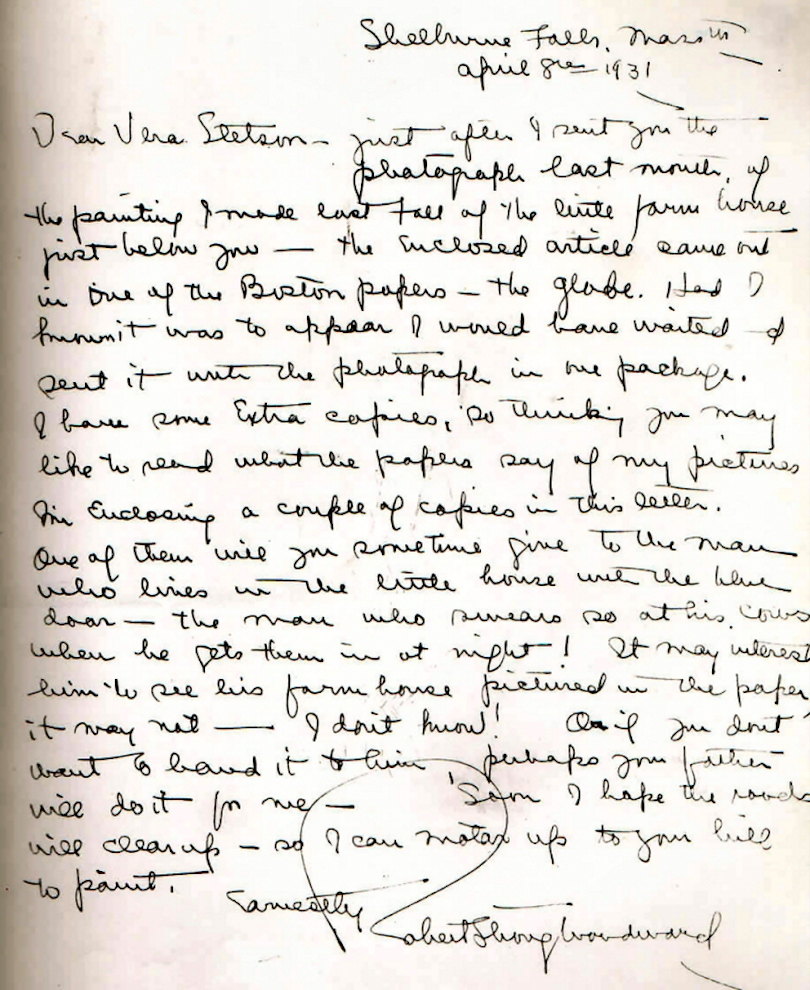
 Vera Stetson Letter Re: Portrait of a Shadow
Vera Stetson Letter Re: Portrait of a Shadow
Transcription of the Letter:
Shelburne Falls, Mass.
April 8th 1931
Dear Vera Stetson__
just after I sent you the photograph last month, of the painting I made
last fall of the little farmhouse just below you __ the enclosed article came out in one of the Boston
papers __ the globe. Had I known it was to appear I would've waited and sent it with the photograph in
one package. I have some extra copies, so thinking you may like to read what the papers say of my
pictures I'm enclosing a couple of copies in this letter. One of them will use some time give to the man
who lives in the little house with the blue door __ the man who swears so at his cows when he gets them
in at night! It may interest him to see his farmhouse pictured in the paper, it may not __ I don't know!
Oh if you don't want to hand it to him, perhaps your father will do it for me __ soon I hope the roads
will clear up __ so I can motor up to your hill to paint.
Earnestly,
Robert Strong Woodward
The 1944 Mr. & Mrs. Roger Smith Exhibition:
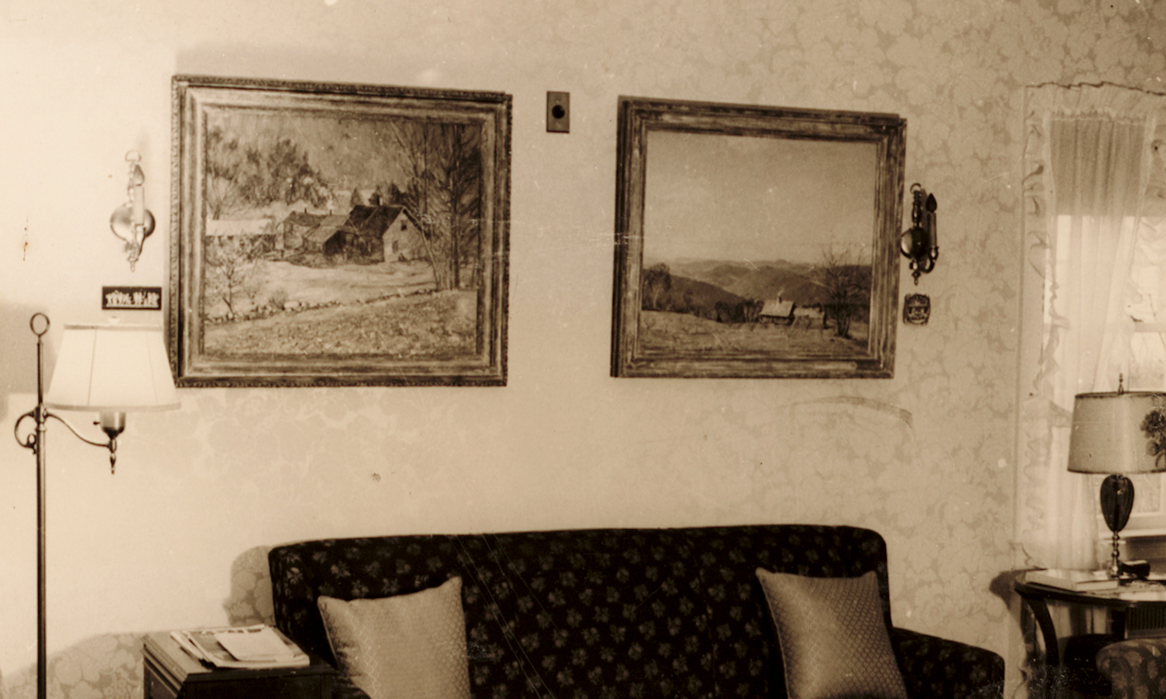
 Portrait of a Shadow and A Mountain Farm hanging
Portrait of a Shadow and A Mountain Farm hanging
in the home of Roger Smith for a private exhibition
 To the right: is a photograph of Portrait of a Shadow,
along with From a Mountain Farm hanging on the wall for a
private exhibition in the home of Mr. & Mrs. Roger Smith of Gardner, MA, December, 1944. The picture was
taken by Woodward friend, educator, and amateur photo-grapher F. Earl Williams.
Williams was once the principal of Gardner High School and so we believe he had something to do with arranging this
rare exhibition of Wood-ward's paintings in a private residence. The three missing photographs are
New England Impressions*, Winter Farms, and
From the North Window*. The paintings photographed are as follows in pairs: Portrait of a Shadow
and From a Mountain Farm*, April Sun and
Frost on the Window, A Winter Song* and
The Big Chimney*, there is the chalk drawing The Road Home, the oil
A Winter Afternoon and other chalk
Mountain Meadow together and then Tranquility, and
The Little Red Barn* as singles.
To the right: is a photograph of Portrait of a Shadow,
along with From a Mountain Farm hanging on the wall for a
private exhibition in the home of Mr. & Mrs. Roger Smith of Gardner, MA, December, 1944. The picture was
taken by Woodward friend, educator, and amateur photo-grapher F. Earl Williams.
Williams was once the principal of Gardner High School and so we believe he had something to do with arranging this
rare exhibition of Wood-ward's paintings in a private residence. The three missing photographs are
New England Impressions*, Winter Farms, and
From the North Window*. The paintings photographed are as follows in pairs: Portrait of a Shadow
and From a Mountain Farm*, April Sun and
Frost on the Window, A Winter Song* and
The Big Chimney*, there is the chalk drawing The Road Home, the oil
A Winter Afternoon and other chalk
Mountain Meadow together and then Tranquility, and
The Little Red Barn* as singles.
And what an exhibition! Worthy of any New York or Boston Gallery, it featured a number of Woodward's most exhibited
editorial paintings going back as far as 1935.[noted by an asterisk*] Two of the paintings hanging at the exhibit,
A Winter Song and New England Impression previously hung at the 1939 Golden Gate Exposition in San
Francisco and the 1939 New York World's Fair respectively.

.png)
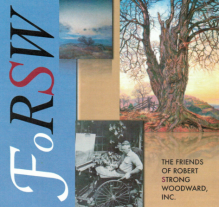
734.png)